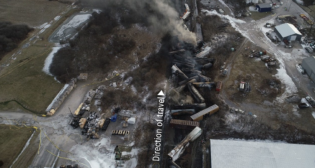
Why bitumen isn’t necessarily safer than Bakken
Written by David Thomas, Canadian Contributing Editor
The chain reaction fireballs that attended the Feb. 16, 2015 derailment of a CSX unit oil train in populated West Virginia probably blinded observers to the significance of the concurrent derailment and explosions of a CN oil train in a remote and uninhabited area of northern Ontario. Most reports treated the two events as equals, given that both trains consisted of recently manufactured CPC-1232 tank cars loaded with crude oil.
CN’s Ontario conflagration is the more disturbing of the two mishaps: The railroad reported that its train was not carrying the extra-light Bakken crude that, in a series of high-energy derailments since 2013, has proved to be explosive. To the contrary, the CN train was laden with bitumen, the extra-heavy tarry substance extracted from Alberta’s oil sands.Undiluted bitumen alone, with a flash point of +151ºC, is considered essentially non-flammable in a derailment event and is rarely considered in safety evaluations of crude by rail.
So why did the bitumen ignite and explode in Ontario’s -40ºC (-40ºF) weather? The reason, based on research consulted by Railway Age, is that the diluent added to make bitumen flow into and out of tank cars makes the blended lading quite volatile.
This blend of bitumen and petroleum-based diluents, known as “dilbit,” has a low flash point. Thus, the widespread belief that bitumen from Alberta’s northern oil sands is far safer to transport by rail than Bakken crude is, for all intents and purposes, dead wrong. This may be disruptive news for bitumen shippers, carriers, and regulators.
The hope for Bakken crude is that it can be treated to remove benzene and other “light end” substances before loading, rendering it mildly flammable instead of highly explosive. The same is not true for dilbit, because the highly volatile diluents are added to the crude to make it less viscous. A safer procedure is to heat bitumen at origin before loading into a tank car and again at destination, prior to unloading. Some tank cars are equipped with internal steam coils for this purpose and are used in crude oil service, but a requirement for such heating elements is not included in the specifications proposed for a future DOT-117 tank car to replace both the DOT-111 and CPC-1232 cars now in CBR service.
According to “Properties of Dilbit and Conventional Crude Oils,” a February 2014 report by the Alberta Innovates consortium of industry, government, and university researchers, “[T]he flash point of fresh dilbit is initially lower than other oil types and is comparable to a diluent.” It says that dilbit will ignite upon exposure to an ignition source at -35ºC, compared to -9ºC for conventional light oil. The flash point of raw diluent is -35ºC or less. The flash point of undiluted bitumen is +151ºC, well above the +60ºC flammability threshold specified in current hazardous materials classification regulations.
The reason for the low flash point of dilbit is that ignitability is determined by a blend’s most volatile components, in this case, the diluent itself: “[T]he flash point is determined by the lowest-boil-point components (volatiles). Consequently, the flash point of the dilbit is governed by the 20%-30% volume diluent component . . . .”
The study defines flash point as “the temperature to which the fuel must be heated in order to produce an adequate fuel/air concentration to be ignited when exposed to an open flame. The flash point of the crude oil is used as an index of fire hazard in North America.”
Thus, flash point is the critical factor in determining whether a tank car breach will lead to its contents burning or exploding upon exposure to the pyrotechnics of a high-energy derailment.
Canada’s Transportation Safety Board can be expected to analyze the dilbit lading of CN’s Ontario accident, as it did the Bakken crude that exploded at Lac-Mégantic in 2013. TSB reported then that Bakken crude is more volatile than other varieties. Should TSB conclude that dilbit has a volatility similar to Bakken crude, as the Alberta research suggests, the hazmat classification of crude oil could be in question.



